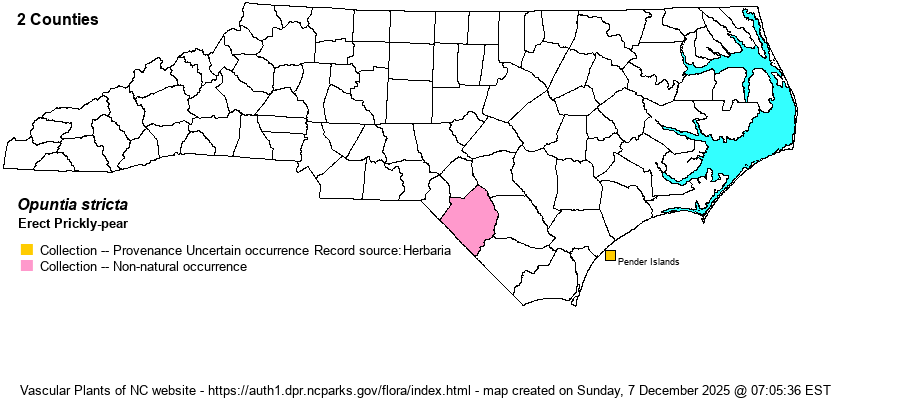| Author | (Haworth) Haworth | |
| Distribution | Restricted to the southern coast, where not clear if a native species or not. A specimen from Robeson County at NCU is here considered likely not natural. Weakley (2022) mentions both var. dillenii and var. stricta as occurring in NC (as native), but the two specimens in SERNEC are both for the nominate variety. For now, the editors will simply put the records and account for the full species until the dust is settled regarding var. dillenii.
Southeastern NC and Gulf Coast south to southern FL. Whether the species is truly native as far north as NC is open to question, especially considering the nature of coastal cacti and the potential for human plantings along the immediate coast. | |
| Abundance | Apparently very rare. "Small (1933) recorded O. stricta (as O. tunoidea) from NC, and the species is still present in dune scrub and grasslands in the southern counties" (Weakley 2022). Weakley's map shows both varieties as "rare". For now, the editors will simply suggest a State Rank of SU (Undetermined), and there is some question whether populations in NC are really natural or not. | |
| Habitat | Dunes and other sandy coastal habitats. | |
| Phenology | Flowers from April to June, and fruits from August to December. | |
| Identification | This is an erect shrub, as opposed to low-growing (as in O. drummondii and O. mesacantha). Opuntia lindheimeri also is a taller shrub; see Weakley (2022) for separation. | |
| Taxonomic Comments | Taxonomy of this genus is very unsettled, with many name changes, splits, and other issues.
| |
| Other Common Name(s) | Common Prickly-pear, Coastal Prickly-pear | |
| State Rank | [SU] | |
| Global Rank | G4? | |
| State Status | [W4] | |
| US Status | | |
| USACE-agcp | UPL link |
| USACE-emp | UPL link |

